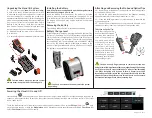
MBR5 User Manual
MBR5 Rev 007
48
•
Bit 2 (query error) is set when a query error occurs, for example, an attempt
is made to read the output queue when the output queue is empty or when
the data in the output queue is lost.
•
Bit 3 (device dependent error) is set by the meter to indicate that an error
has occurred that is not a command error, an execution error, or a query
error.
•
Bit 4 (execution error) is set when an execution error is detected by the
meter, for example, if a command parameter is out of the range of the
meter or a valid program message cannot be executed due to some
condition in the meter.
•
Bit 5 (command error) is set when a command error is detected by the
meter, for example, if a syntax error is detected in a program message, an
incorrect command header is received, or if an IEEE GET message is received
in the middle of a program message.
•
Bit 6 (user request) is always set to 0.
•
Bit 7 (power on) is set when an off-‐to-‐on transition occurs in the power
supply of the meter.
Standard Event Status Enable Register
The contents of the standard event status enable register determine which
events in the standard event status register are reflected in the event summary
bit (ESB) of the status byte register.
Queues
Input Queue
The input queue in the meter is a first-‐in-‐first-‐out (FIFO) queue and is 128
characters in length. Data bytes received from the controller are placed in the
input queue in the order received. When a full message meter is received, it is
transferred to the parser.
If the input queue becomes full while the GPIB is being used, the data
acknowledge signal (DAQ) is not sent to the GPIB controller until a character is
transferred from the input buffer to the parser. This ensures that no bytes in the
program message are lost. However, the RS232C interface has no DAQ signal
Standard Event Status Enable Register
Read with
*ESE?
common query
Written to with
*ESE
common command
Cleared by
Power-‐on
*ESE
common command with a parameter 0
















































